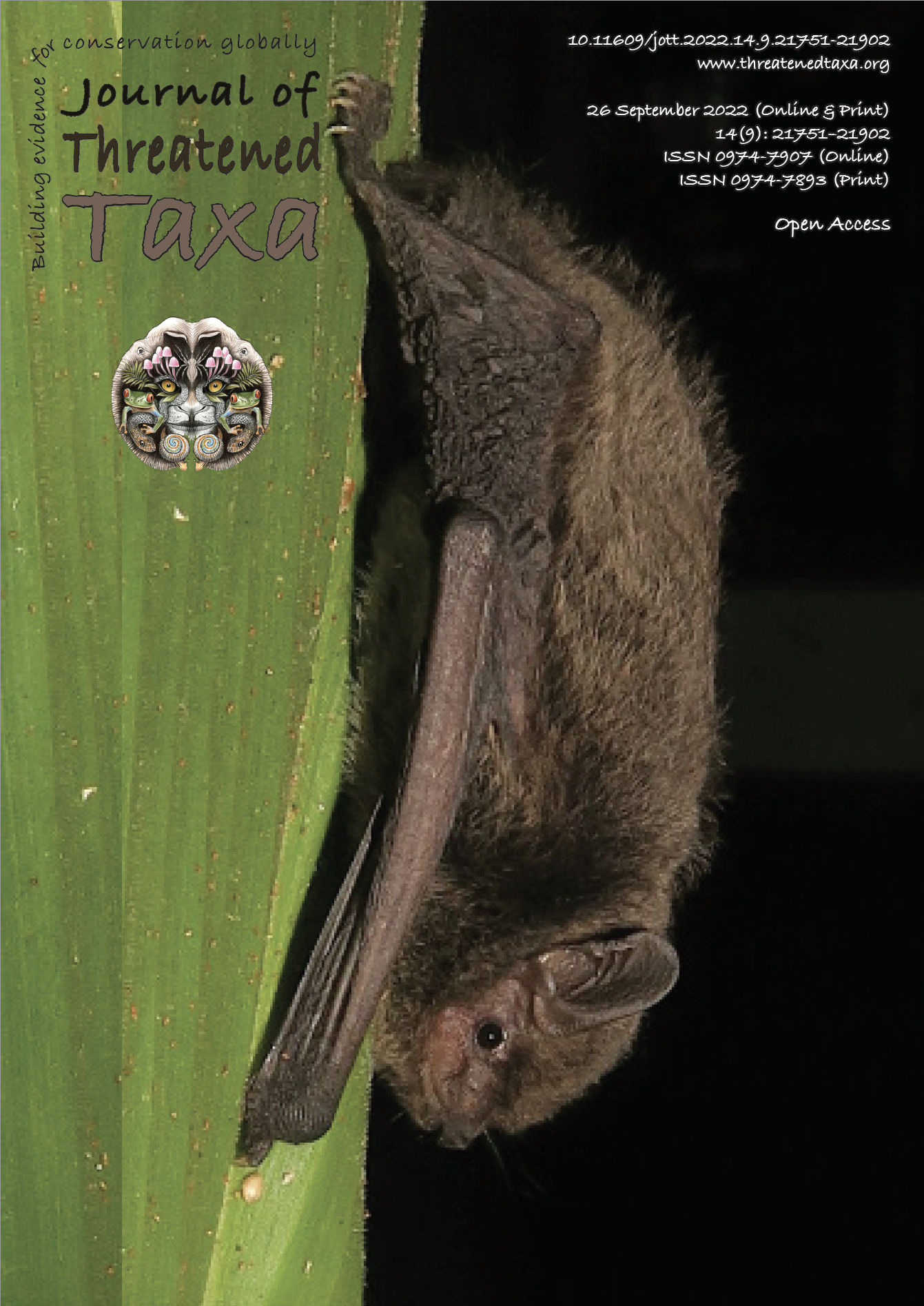First camera-trap confirmation of Tibetan Brown Bear Ursus arctos pruinosus Blyth, 1854 (Mammalia: Carnivora: Ursidae) with a review of its distribution and status in Nepal
DOI:
https://doi.org/10.11609/jott.7797.14.9.21797-21804Keywords:
Distribution, first record, central Himalaya, subspeciesAbstract
The Tibetan Brown Bear Ursus arctos pruinosus is a large mammalian carnivore of high-altitude environments that is closely associated with the pastoral landscape. Limited information is available on this species, probably due to its rarity in the Himalaya. To date, scientific evidence of the presence of Tibetan Brown Bears has not been reported officially. The information presented here is based on data collected in the central Himalayan region of Nepal in 2003–2014 during biodiversity surveys and other research. Methods included random walks along livestock trails, transect surveys, opportunistic camera trapping, and herders’ reports & interviews. This is the first camera-trap confirmation of the Tibetan Brown Bear in the central Himalaya. The distribution map was updated based on direct observation, signs and field reports gathered from reliable sources. The presence of signs (diggings, footprints, and feces) and direct observation in the Annapurna-Manaslu landscape reveal that bears are closely associated with Himalayan marmots and other small rodents. Local folklore, legends, and cultural beliefs have played important roles in Brown Bear conservation in the central Himalaya.
References
Aryal, A., J.B. Hopkins, D. Raubenheimer, W. Ji & D. Brunton (2012). Distribution and diet of Brown Bears in the upper Mustang Region, Nepal. Ursus 23(2): 231–236. https://doi.org/10.2192/URSUS-D-11-00015.1
Aryal, A., S. Sathyakumar & C.C. Schwartz (2010). Current status of Brown Bears in the Manasalu Conservation Area, Nepal. Ursus 21(1): 109–114. https://doi.org/10.2192/09GR029.1
Bojarska, K. & N. Selva(2012). Spatial patterns in Brown Bear Ursus arctos diet: the role of geographical and environmental factors. Mammal Review 42(2): 120–143. https://doi.org/10.1111/j.1365-2907.2011.00192.x
Chetri, M. (2008). Brown Bear (Ursus arctos) from Upper Mustang. Prakriti 15: 19-22. Newsletter of the National Trust for Nature Conservation, Kathmandu, Nepal.
Chetri, M., M. Odden & P. Wegge (2017). Snow leopard and Himalayan wolf: food habits and prey selection in the Central Himalayas, Nepal. PLoS One 12(2): e0170549. https://doi.org/10.1371/journal.pone.0170549
CITES. (2019). The CITES appendices. Appendices I, II & III (04/04/2017), 16. 26 July 2019. https://cites.org/sites/default/files/eng/app/2017/E-Appendices-2017-10-04.pdf
Evans, A.L., N.J. Singh, A, Friebe, J.M. Arnemo, T. Laske, O. Fröbert, J.E. Swenson & S. Blanc (2016). Drivers of hibernation in the Brown Bear. Frontiers in zoology 13(1): 1–14. https://doi.org/10.1186/s12983-016-0140-6
Fowler, N.L., J.L. Belant, G. Wang & B.D. Leopold (2019). Ecological plasticity of denning chronology by American black bears and Brown Bears. Global Ecology and Conservation 20: e00750. https://doi.org/10.1016/j.gecco.2019.e00750
González‐Bernardo, E., L.F. Russo, E. Valderrábano, A. Fernández & V. Penteriani (2020). Denning in Brown Bears. Ecology and Evolution 10(13): 6844–6862. https://doi.org/10.1002/ece3.6372
Hissa, R. (1997). Physiology of the European Brown Bear (Ursus arctos arctos).Annales Zoologici Fennici 34(4): 267–287.
Jnawali, S., H. Baral, S. Lee, K. Acharya, G. Upadhyay, M. Pandey, R. Shrestha, D. Joshi, B.R. Lamichhane, J. Griffiths, A.P. Khatiwada, N. Subedi & R. Amin (2011). The Status of Nepal’s Mammals: The National Red List Series-IUCN. Department of National Parks and Wildlife Conservation, Kathmandu, Nepal, 276 pp.
Kadariya, R., M. Shimozuru, J.E. Maldonado, M.A.M. Moustafa, M. Sashika & T. Tsubota (2018). High genetic diversity and distinct ancient lineage of Asiatic black bears revealed by non-invasive surveys in the Annapurna Conservation Area, Nepal. PLoS One 13(12): e0207662. https://doi.org/10.1371/journal.pone.0207662
Lan, T., S. Gill, E. Bellemain, R. Bischof, M.A. Nawaz & C. Lindqvist (2017). Evolutionary history of enigmatic bears in the Tibetan Plateau–Himalaya region and the identity of the yeti. Proceedings of the Royal Society B 284: 20171804. https://doi.org/10.1098/rspb.2017.1804
Lydekker, R. (1897). The Blue Bear of Tibet, with Notes on the Members of the Ursus arctus Group. In Proceedings of the Zoological Society of London 65(2): 412–426. https://doi.org/10.1111/j.1469-7998.1897.tb00025.x
McLellan, B.N., M.F. Proctor, D. Huber & S. Michel (2017). Ursus arctos. The IUCN Red List of Threatened Species 2017: e.T41688A121229971. Accessed 06 February 2022. https://doi.org/10.2305/IUCN.UK.2017-3.RLTS.T41688A121229971.en
McLellan, B.N., M.F. Proctor, D. Huber & S. Michel (2016). Brown Bear (Ursus arctos) Isolated Populations (Supplementary Material to Ursus arctos Redlisting account). The IUCN Red List of Threatened Species 2016. Electronic version accessed 06 February 2022.
Nawaz, M.A., A. Valentini, N.K. Khan, C. Miquel, P. Taberlet & J.E. Swenson (2019). Diet of the Brown Bear in Himalaya: Combining classical and molecular genetic techniques. PLoS One 14(12): e0225698. https://doi.org/10.1371/journal.pone.0225698
Pocock R.I. (1941). The fauna of British India, including Ceylon and Burma. Volume II. Mammalia. Taylor and Francis, London.
Sowerby, A.D.C. (1920). Notes on Heude’s Bears in the Sikawei Museum, and on the Bears of Palæarctic Eastern Asia. Journal of Mammalogy 1(5): 213–233. https://doi.org/10.2307/1373245
Worthy, F. R. & J.M. Foggin (2008). From the field Conflicts between local villagers and Tibetan Brown Bears threaten conservation of bears in a remote region of the Tibetan Plateau. Human-Wildlife Conflicts 2(2): 200–205.
Wu, L. (2014). Ecological study on human‐Brown Bear conflicts in Sanjiangyuan area, Tibetan Plateau, China. PhD Thesis, Peking University, Beijing.
Published
Versions
- 26-09-2022 (2)
- 26-09-2022 (1)
Issue
Section
License
Copyright (c) 2022 Madhu Chetri

This work is licensed under a Creative Commons Attribution 4.0 International License.
Authors own the copyright to the articles published in JoTT. This is indicated explicitly in each publication. The authors grant permission to the publisher Wildlife Information Liaison Development (WILD) Society to publish the article in the Journal of Threatened Taxa. The authors recognize WILD as the original publisher, and to sell hard copies of the Journal and article to any buyer. JoTT is registered under the Creative Commons Attribution 4.0 International License (CC BY), which allows authors to retain copyright ownership. Under this license the authors allow anyone to download, cite, use the data, modify, reprint, copy and distribute provided the authors and source of publication are credited through appropriate citations (e.g., Son et al. (2016). Bats (Mammalia: Chiroptera) of the southeastern Truong Son Mountains, Quang Ngai Province, Vietnam. Journal of Threatened Taxa 8(7): 8953–8969. https://doi.org/10.11609/jott.2785.8.7.8953-8969). Users of the data do not require specific permission from the authors or the publisher.





